


|
|
|
WHAT makes the food of Panchgani somewhat distinct from the general cuisine of Maharashtra is the masala the people of the hill-station use in their cooking. It is, for want of a better name, simply described as Ghati Masala.
Ghati, of course, is the somewhat derogatory nickname for the Maharashtrian who comes from the other side of the Ghats; meaning the rural citizen as opposed to the townie. Ghatis are actually a simple people who would not give up living in the hills for all the attractions of a city.
And perhaps, it is because this Maharashtrian in Panchgani is a Ghati, that he jazzes up his food with that extra hint of spice. The cool climes of the hill-station create a hunger that can only be satiated by food that is robust, wholesome, and spicy in content.
Using your fingers, take a piece of Bhakri, scoop up a morsel of chicken curry and all, and pop it into your mouth. That is how the Ghatis of Panchgani eat.
The Brahmins of Panchgani avoid garlic and onion and yet produce a cuisine that is delectable.
Shobha Suresh Datar, a shy and friendly housewife living on the slopes of the hill-station, is reckoned by the people around to be one of the finest cooks of the Panchgani-type of food. She caters to small families and bachelors living in Panchgani. And to whoever has heard of the merits of her food and wants to sample Ghati cuisine.
Like the Bharlela Wangi. She stuffs fresh, organically-grown baby brinjals with peanut, coconut, kothmir, the Ghati Masala, and salt and deep-fries it in peanut oil. The stuffing comes out of the brinjal and forms a thick masala.
And she does Pithla, which is a great Maharashtrian favourite, and popularly known elsewhere in the state as Zunkha Bhakar. It is a simple Chana Dal flour, kothmir, chilli powder, jeera
and salt.
The rice of the hill-station is a Moong Dal Khichdi, a fragrant and tasty dish made rice got especially from Khedgaon for this.
�It is a single polish rice and there is great demand for it,� says Shobha. The rice and Moong Dal are cooked with the Ghati Masala in a cooker. �Wait for two whistles,� says Shobha, �then remove it and have.� The quality of the rice and the masala is what makes this dish so popular.
You are advised to eat it like a pickle. It is sheer gunpowder! Green chilli, peanuts, garlic too is used in this recipe, little salt are all mixed and dry ground. The mixture is fried in peanut oil. It brings the saliva to the mouth, the Mirch Kharda is so spicy.
And the popular �sweet dish�, as Shobha says of the dessert, in Panchgani is Sheera. This is the Maharashtrian Sheera, not the South Indian Rava Kesari. Milk is used to boil the rava, sugar, plums, cardamoms and almonds, then a little ghee is added to fry the mixture, and finally a little water.
|

Home Page
About the mag
Subscribe
Advertise
Contact Us

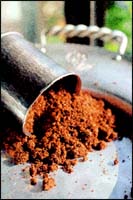 Ghati Masala! The Spice Of Life In Panchgani
Ghati Masala! The Spice Of Life In Panchgani
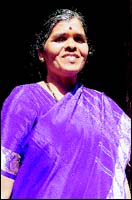 Like the Kombdi Masala, a watery thin chicken curry spiced with red hot chillies and black pungent peppers. This is best enjoyed with the jowar roti called Bhakri and a garlic chutney.
The Bhakri is not a soft, absorbing bread, so you cannot dunk it into the chicken curry and hope to soak in the curry.
Like the Kombdi Masala, a watery thin chicken curry spiced with red hot chillies and black pungent peppers. This is best enjoyed with the jowar roti called Bhakri and a garlic chutney.
The Bhakri is not a soft, absorbing bread, so you cannot dunk it into the chicken curry and hope to soak in the curry. 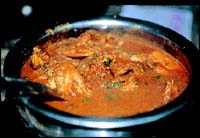 A Maharashtrian thali costs Rs. 40. It is absolutely sumptuous and great value for money. Shobha's specialities are all standard Maharashtrian dishes from Panchgani.
A Maharashtrian thali costs Rs. 40. It is absolutely sumptuous and great value for money. Shobha's specialities are all standard Maharashtrian dishes from Panchgani.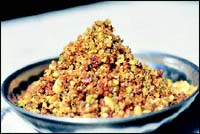 No onions and no garlic. The ingredients are mixed in peanut oil and stirred until a thick consistency is formed. A little water is added to smoothen the paste and then this is dried out. It tastes awesome with the Bhakri.
No onions and no garlic. The ingredients are mixed in peanut oil and stirred until a thick consistency is formed. A little water is added to smoothen the paste and then this is dried out. It tastes awesome with the Bhakri.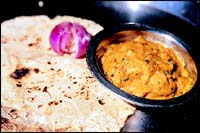 There is another speciality of Panchgani, though this dish originated in Satara, it is called Mirch Kharda.
There is another speciality of Panchgani, though this dish originated in Satara, it is called Mirch Kharda.